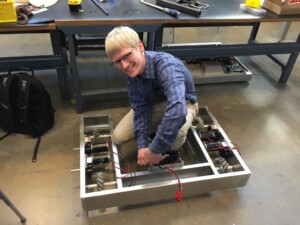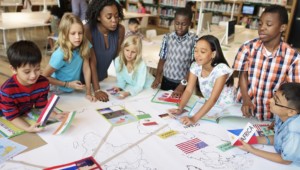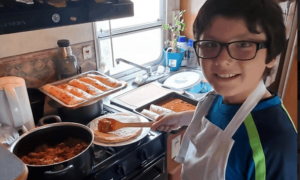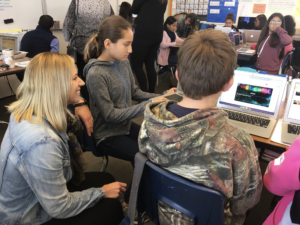Amplify Storytelling in the Classroom with 3 Tech-Enabled Projects

By: Robert Sevilla
More than 63 percent of U.S. K-12 teachers use varying forms of technology in their classroom. Without a doubt, technology has not only transformed teaching and learning, but also plays a significant role in how students are prepared for college and career. However, research shows that the majority of technology integration in the classroom takes place as a substitute for traditional methods, rather than presenting a new learning opportunity — 60 percent of the time students are using technology, they are passive consumers rather than using it to “practice the higher-level technology skills that are required for many jobs.”
In my technology class, I apply the well-known SAMR model to ensure that students are not merely consuming technology, but instead are learning to leverage these digital tools in a variety of ways to amplify their ideas. Through the lens of storytelling, I help students embrace the power of student voice while honing their communication skills — a highly valued attribute in today’s workforce. By using a variety of online tools, students gain essential 21st century skills that will help them succeed in the classroom and beyond.
Three Projects That Promote Storytelling Online
In today’s digital learning environment, students need to start by learning foundational skills such as keyboarding, digital literacy, and digital citizenship. My computer technology course for seventh and eighth graders is anchored by three projects that require active participation, build comfort with a variety of technology, and teach them to leverage those tools to become effective storytellers in a digital context.
Project #1: Sharing Digital Literacy Insights Through Blogging
It may seem obvious (or it may be so obvious that it becomes easy to overlook), but typing is perhaps the most important foundational skill students must learn to be up-to-speed in today’s wired classrooms. My students use Typing.com for the first 10 minutes of class each day to learn proper keyboarding technique as well as touch-typing skills. After learning the basics of the ‘home row,’ they proceed all the way through advanced punctuation, while also learning proper hand position, body posture, and accuracy. Students immediately apply their new typing skills using KidBlog, where they write their own blogs. For example, they may be prompted to answer questions about the lasting effects of a digital footprint or respond to Common Sense’s digital citizenship videos. The platforms allows for them to receive constructive, written feedback by myself and their peers.
Project #2: Storytelling with Podcasts
Later in the course, students learn the basics of podcasting, a form of media that represents an exciting new addition to their storytelling skillset. Students start by listening to and reviewing three podcast episodes on their blog to identify different storytelling techniques, such as shorter, snappier sentences or the use of natural sound to amplify the narrative. After choosing a topic for their own podcast, they collaborate on a script using Google docs and then use GarageBand to record, edit, and embed sound effects into their podcast. Some students also create their own podcast logo using Google Presentations or the GIMP image editor. Both the script and final recording are uploaded to their KidBlog page, which serves as a digital portfolio to showcase their growth.
Project #3: Producing an Instructional Video
The final project takes storytelling a step further by tasking students with creating a three-minute instructional video. Students break into teams, identify team roles, choose a topic, and begin to draft a script. They collaborate on a storyboard with in-depth scene descriptions, camera shots, and angles, shoot video, and edit using programs such as iMovie, Final Cut Pro, and Windows Movie Maker. They then upload their final product to their digital portfolio on KidBlog and present it to the class.
Storytelling in the Digital Age
Storytelling has always been a central theme in my class, but prior to the advent of these awesome and easy-to-access tech tools, students were limited to pen, paper, and oral presentation. Today, students can use a variety of formats and tools to share their unique thoughts and perspectives. Their digital storytelling skills not only translate into academic success, but also equip them with a tremendous amount of self-confidence and the digital know-how to navigate the future of work.
For more, see:
- How and Where EdTech Will Help
- The Best EdTech Tool is an Empowered Teacher
- Empowering Students and Teachers for the 21st Century
Robert Sevilla began his educational career as a music and math educator and for the past 13 years has taught computer technology at Chaboya Middle School in San Jose, California. A lifelong learner himself, Robert obtained an M.A. in Educational Technology in 2010. Robert still brings his musical background and passion for multimedia to help create interesting, authentic, and real-world projects. Follow Robert on Twitter @rrksevilla
Stay in-the-know with innovations in learning by signing up for the weekly Smart Update.





0 Comments
Leave a Comment
Your email address will not be published. All fields are required.